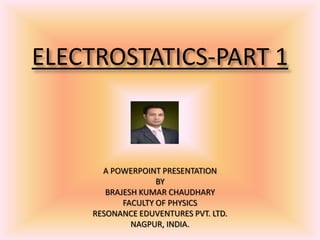
Electrostatics -1
- 1. ELECTROSTATICS-PART 1 A POWERPOINT PRESENTATION BY BRAJESH KUMAR CHAUDHARY FACULTY OF PHYSICS RESONANCE EDUVENTURES PVT. LTD. NAGPUR, INDIA.
- 2. ELECTROSTATICS GIRL SAFELY CHARGED TO SEVERAL HUNDRED THOUSAND VOLTS GIRL IN GREAT DANGER AT SEVERAL THOUSAND VOLTS The branch of Physics which deals with electric effects of static charge is called electrostatics.
- 4. ELECTRIC CHARGE Charge of a material body or particle is the property due to which it produces & experiences electrical & magnetic effects. Where do charges come from? Matter is made up of atoms. An atom consists of proton , neutron & electron. Proton = + ve charge Electron= - ve charge Neutron = no charge
- 5. Unlike attract - + Unlike attract + - - + Like repel Like repel Charges are of two types. (a)Positive & (b) Negative. Like charges (+ve &+ve or –ve & -ve) repel. Unlike charges (+ve & -ve) attract.
- 6. PROPERTIES OF CHARGE(Contd.) CONSERVATION OF CHARGE In an isolated system, sum of total charge remains constant whatever change takes place in that system. QUANTIZATION OF CHARGE Charge of a particle or a body is always an integral multiple of a fundamental unit of electric charge (e). i.e. 19 , 1.6 10Q ne e C
- 7. PROPERTIES OF CHARGE(Contd.) •Charge is always associated with mass. Charge can’t exist without mass though mass can exist with charge. •Charge is relativistically invariant. •Charge is a scalar quantity. Its S.I. unit is Coulomb(C ). •A Charge at rest produces only electric field around itself. •A charge moving with uniform velocity produces electric & magnetic field both. •An accelerated charge emits electromagnetic radiations.
- 8. Numerical Problem #1 Estimate the number of electrons of 100 g of water. How much is the total negative charge on the these electrons.
- 9. CONDUCTOR,INSULATOR & SEMICONDUCTOR •In a conducting material, the outer electrons of the atoms are loosely bound and free to move through the material. •Semiconductors are between conductors & insulators. •In a insulating material, the outer electrons of the atoms are tightly bound and are not free to move through the material.
- 10. CONDUCTOR,INSULATOR & SEMICONDUCTOR Property of material: conductivity 1. Conductors transmit charges readily. 2. Semiconductors are intermediate; their conductivity can depend on impurities and can be manipulated by external voltages. 3. Insulators do not transmit charge at all.
- 11. GROUNDING An object is grounded when it is connected to the earth through a connecting wire. If a charged conductor is grounded, it will become neutral. One symbol that is often used to show that something is grounded is:
- 12. How does grounding occur? When we touch a metal ball of positive charge... •Electrons flow from the earth to the metal ball to neutralize the metal ball. •Metal ball becomes neutral. + + + ++
- 13. HOW DOES GROUNDING OCCURS?(Contd.) – – – –– Similarly, if the metal ball is of negative charge... Extra electrons flow from the metal ball to the earth and the ball becomes neutral.
- 14. METHODS OF CHARGING OF A BODY Primarily a body can be charged by six methods namely, (a)By friction (b)By Conduction (c)By Induction (d)By thermionic emission (e)By Photoelectric effect (f) By Field emission
- 15. CHARGING BY FRICTION When insulators are rubbed together, one gives up electrons and becomes positively charged, while the other gains electrons and becomes negatively charged. Common examples of charging by friction: • small shocks from a doorknob after walking on carpet with rubber-soled shoes •laundry from the dryer that clings • balloon rubbed with hair sticks that to a wall
- 16. CHARGING BY CONDUCTION When a charged conductor makes contact with a neutral conductor there is a transfer of charge. Electrons are transferred from the rod to the ball, leaving them both negatively charged. Electrons are transferred from the ball to the rod, leaving them both positively charged
- 17. CHARGING BY INDUCTION (a) (b) © (d) STEPS (a) Bring a negatively charged rod near a neutral conducting sphere.Due to repulsion from rod free electrons of conducting sphere move away from rod. Thus a net positive charge appears near rod and negative charge away from rod. (b) Now connect the sphere to ground through a conducting wire from the side where negative charges appear. (c) Due to grounding the negative charges flow to the ground, leaving the sphere positively charged. (d) Now, remove the rod. The positive charges on the sphere arrange themselves uniformly.
- 18. ELECTROSCOPE Electroscope is a device which detects any charge on an object.
- 19. ELECTROSCOPE The electroscope can be charged either by conduction or by induction.
- 20. ELECTROSCOPE(Contd.) The charged electroscope can then be used to determine the sign of an unknown charge.
- 21. ELECTROSCOPE(Contd.) When the knob is charged, electric charge travels along the rod and into the leaves. Then, the leaves repel each other because they have the same charge.
- 22. CONCEPT QUESTION #1 +Q If a positively charged object is placed near an uncharged conductor, will it experience any force or not? If yes, then attractive or repulsive? Will the answer change if charge in question is negative?
- 23. CONCEPT QUESTION #2 Five Styrofoam balls A, B,C,D & E are used in an experiment and following observations were made: (a)A attracts B but repels C (b)D attracts B but doesn’t have any effect on E (c) A negatively charged rod attracts both A & E. What can you say about charges on balls A,B,C,D &E?
